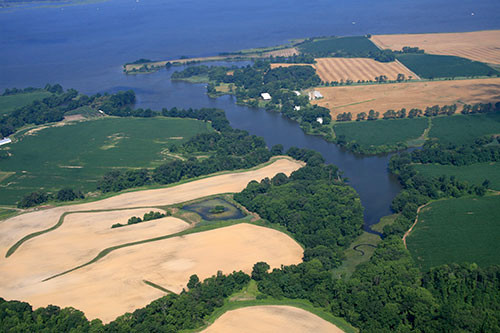Testimony to the Maryland General Assembly in support of compulsory soil phosphorus testing by farmers
Bill Dennison ·Yesterday, I provided testimony to the Maryland General Assembly in support of a bill that would require Maryland farmers to conduct soil testing for phosphorus levels and to report their findings. The bill was sponsored by Senator Pinsky and my testimony was to the Education, Health, and Environmental Affairs committee, chaired by Senator Joan Carter Conway. My written submission follows:
Dr. William C. Dennison
5 March 2013
My name is Dr. William “Bill” Dennison and I am providing this written testimony as a scientist at the University of Maryland Center for Environmental Science in support of SB739.
For the past decade, I have been working on developing better reporting and tracking mechanisms for Chesapeake Bay restoration. I have worked with the Chesapeake Bay Program to develop data analysis tools and procedures so that we can better understand the very real progress that has been made and the challenges ahead. I have also worked with the EcoCheck group and various citizen science groups to develop publically available Chesapeake Bay and tributary report cards. In addition, I have also worked with various practitioners and restoration specialists to generate fact sheets, booklets and presentations in which the various approaches to restoration are rigorously evaluated. What I have learned in the decade of attempting to better report and track Chesapeake Bay restoration is that we are fundamentally data limited at the scale of the farm. While we have adequate tracking of the mainstem of Chesapeake Bay through the Chesapeake Bay Program partnership, and we are attempting to make up for the deficit in tributary monitoring through citizen scientists, we fundamentally lack data at the scale of the farm fields.

The reason that we need data at the scale of the farm field is to be able to rigorously evaluate the effectiveness of various farm practices in reducing nutrient runoff. The proposed bill requires soil testing, which in combination with data on nutrient application rates and nutrient concentrations in runoff, would provide an integrated assessment of on site effectiveness of various farming practices. There are scores of available best management practices that are being employed, and numerous variations and different combinations of these practices being used. Yet, we cannot adequately evaluate which of these practices or combination of practices will result in a) the best farm yields combined with b) the best conservation outcomes. We have developed elaborate formulas for nutrient accounting of various best management practices for use in Water Implementation Plans, yet we are not developing the monitoring and tracking data to see if these formulas are applicable in the different regions of the Chesapeake watershed.
One of the central tenets of environmental stewardship that has been embraced in Chesapeake Bay is that of adaptive management. This approach of “Learning by Doing” relies on monitoring and evaluation so that the strategies for management actions can be tested and modified accordingly. The only way to learn is to collect data that can be used to evaluate practices.
On the subject of who should pay for soil testing, I have worked with various scientific agencies and academic institutions around Chesapeake Bay to ensure that we are getting the most from the existing monitoring program under current funding levels. We have stretched the monitoring dollars by embracing new technologies, partnering with various groups, and trimming everywhere we could. We have also reallocated significant monitoring funds from Chesapeake Bay to develop better watershed monitoring capability. However, it is apparent to me that the scientific community (both academia and government agencies) does not have the resources for monitoring at the scale of the farm unit, and likely, never will. The best that we can hope for is a broad scale monitoring approach that can detect trends that occur over multiple years in relatively large watershed units. If we expect to be able to provide timely feedback on the investments that farmers are making with nutrient management plans and that government is making with various incentive programs (e.g., cover crops), then more monitoring will be required.
There are various watershed and estuarine models that have been developed for planning purposes and to develop scenarios of which management actions would result in Chesapeake Bay restoration. But ultimately it is the monitoring data, not the modeling outputs, that needs to be used to evaluate real progress. Tracking our investments in environmental implementation just makes good sense.
About the author
Bill Dennison

Dr. Bill Dennison is a Professor of Marine Science and Vice President for Science Application at the University of Maryland Center for Environmental Science.


